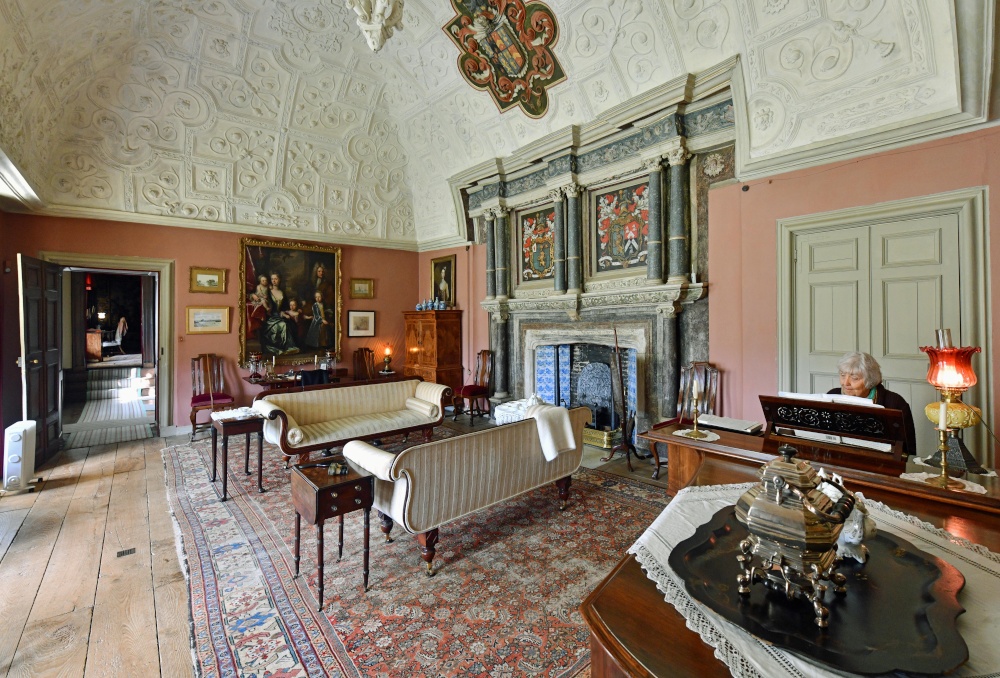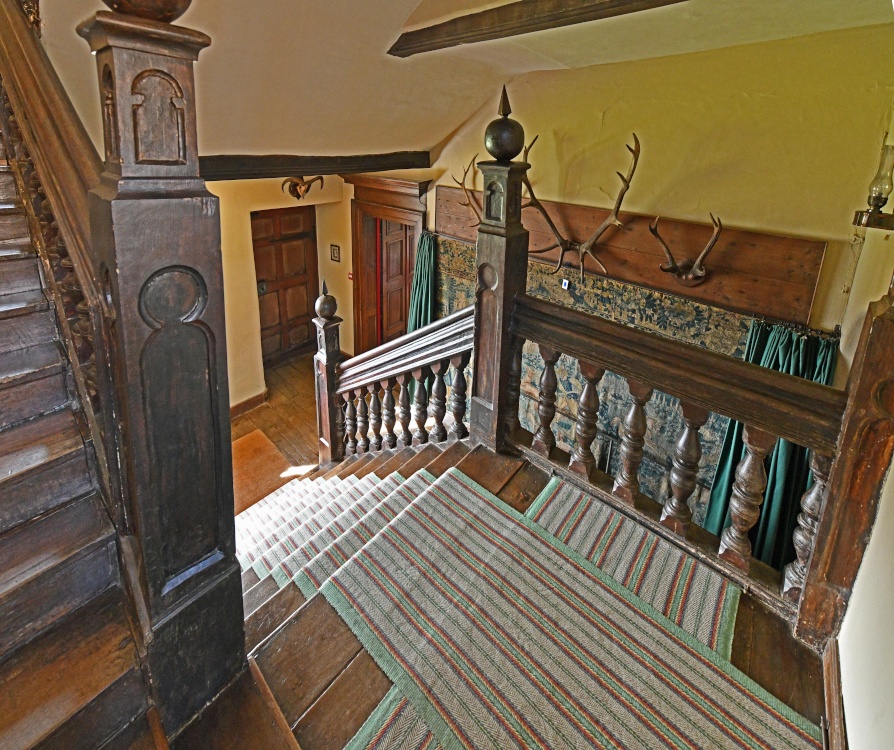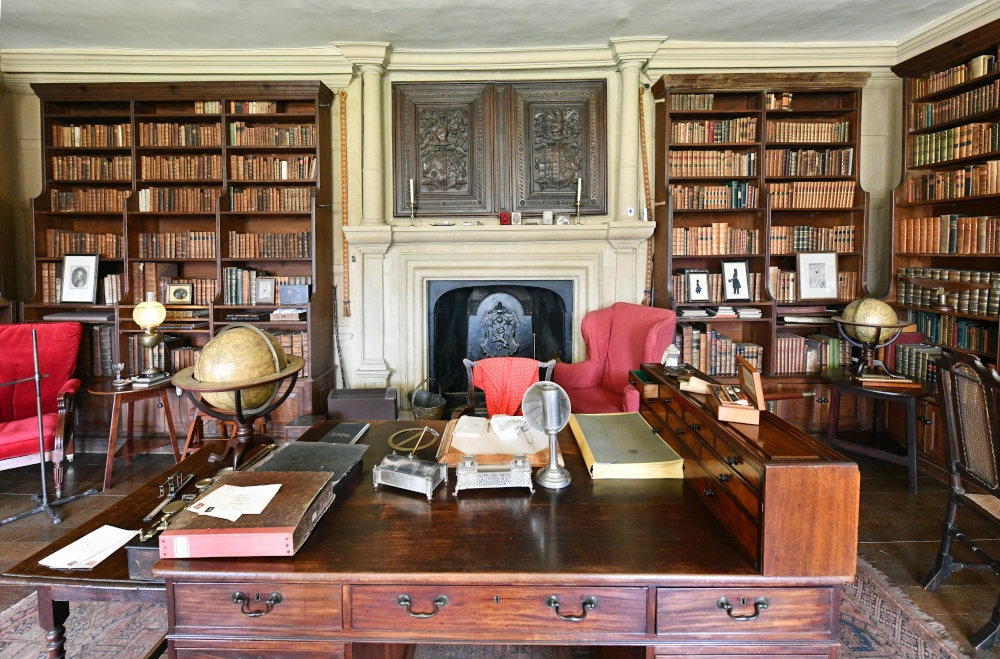Please login or click here to join.
Forgot Password? Click Here to reset pasword
 |
Canons Ashby House Interior, clock mechanism from local church The house had been the home of the Dryden family since its construction in the 16th century; the manor house was built in approximately 1550 with additions in the 1590s, in the 1630s and 1710. The interior of Canons Ashby House is noted for its Elizabethan wall paintings and its Jacobean plasterwork. It has remained essentially unchanged since 1710 and is presented as it was during the time of Sir Henry Edward Leigh Dryden (1818–1899), a Victorian antiquary with an interest in history. This picture appears in the following picture tour: Camera Make: NIKON CORPORATION� Model: NIKON D850� |
 |
Canons Ashby House Interior The house had been the home of the Dryden family since its construction in the 16th century; the manor house was built in approximately 1550 with additions in the 1590s, in the 1630s and 1710. The interior of Canons Ashby House is noted for its Elizabethan wall paintings and its Jacobean plasterwork. It has remained essentially unchanged since 1710 and is presented as it was during the time of Sir Henry Edward Leigh Dryden (1818–1899), a Victorian antiquary with an interest in history. This picture appears in the following picture tour: Camera Make: NIKON CORPORATION� Model: NIKON D850� |
 |
Canons Ashby House Interior The house had been the home of the Dryden family since its construction in the 16th century; the manor house was built in approximately 1550 with additions in the 1590s, in the 1630s and 1710. The interior of Canons Ashby House is noted for its Elizabethan wall paintings and its Jacobean plasterwork. It has remained essentially unchanged since 1710 and is presented as it was during the time of Sir Henry Edward Leigh Dryden (1818–1899), a Victorian antiquary with an interest in history. This picture appears in the following picture tour: Camera Make: NIKON CORPORATION� Model: NIKON D850� |
 |
Canons Ashby House Interior The house had been the home of the Dryden family since its construction in the 16th century; the manor house was built in approximately 1550 with additions in the 1590s, in the 1630s and 1710. The interior of Canons Ashby House is noted for its Elizabethan wall paintings and its Jacobean plasterwork. It has remained essentially unchanged since 1710 and is presented as it was during the time of Sir Henry Edward Leigh Dryden (1818–1899), a Victorian antiquary with an interest in history. This picture appears in the following picture tour: Camera Make: NIKON CORPORATION� Model: NIKON D850� |
 |
Canons Ashby House Interior The house had been the home of the Dryden family since its construction in the 16th century; the manor house was built in approximately 1550 with additions in the 1590s, in the 1630s and 1710. The interior of Canons Ashby House is noted for its Elizabethan wall paintings and its Jacobean plasterwork. It has remained essentially unchanged since 1710 and is presented as it was during the time of Sir Henry Edward Leigh Dryden (1818–1899), a Victorian antiquary with an interest in history. This picture appears in the following picture tour: Camera Make: NIKON CORPORATION� Model: NIKON D850� |
 |
Canons Ashby House Interior, servant's quarter The house had been the home of the Dryden family since its construction in the 16th century; the manor house was built in approximately 1550 with additions in the 1590s, in the 1630s and 1710. The interior of Canons Ashby House is noted for its Elizabethan wall paintings and its Jacobean plasterwork. It has remained essentially unchanged since 1710 and is presented as it was during the time of Sir Henry Edward Leigh Dryden (1818–1899), a Victorian antiquary with an interest in history. This picture appears in the following picture tour: Camera Make: NIKON CORPORATION� Model: NIKON D850� |
 |
Canons Ashby House Interior The house had been the home of the Dryden family since its construction in the 16th century; the manor house was built in approximately 1550 with additions in the 1590s, in the 1630s and 1710. The interior of Canons Ashby House is noted for its Elizabethan wall paintings and its Jacobean plasterwork. It has remained essentially unchanged since 1710 and is presented as it was during the time of Sir Henry Edward Leigh Dryden (1818–1899), a Victorian antiquary with an interest in history. This picture appears in the following picture tour: Camera Make: NIKON CORPORATION� Model: NIKON D850� |
 |
Canons Ashby House Interior The house had been the home of the Dryden family since its construction in the 16th century; the manor house was built in approximately 1550 with additions in the 1590s, in the 1630s and 1710. The interior of Canons Ashby House is noted for its Elizabethan wall paintings and its Jacobean plasterwork. It has remained essentially unchanged since 1710 and is presented as it was during the time of Sir Henry Edward Leigh Dryden (1818–1899), a Victorian antiquary with an interest in history. This picture appears in the following picture tour: Camera Make: NIKON CORPORATION� Model: NIKON D850� |
 |
Canons Ashby House Interior The house had been the home of the Dryden family since its construction in the 16th century; the manor house was built in approximately 1550 with additions in the 1590s, in the 1630s and 1710. The interior of Canons Ashby House is noted for its Elizabethan wall paintings and its Jacobean plasterwork. It has remained essentially unchanged since 1710 and is presented as it was during the time of Sir Henry Edward Leigh Dryden (1818–1899), a Victorian antiquary with an interest in history. This picture appears in the following picture tour: Camera Make: NIKON CORPORATION� Model: NIKON D850� |
 |
Canons Ashby House Interior The house had been the home of the Dryden family since its construction in the 16th century; the manor house was built in approximately 1550 with additions in the 1590s, in the 1630s and 1710. The interior of Canons Ashby House is noted for its Elizabethan wall paintings and its Jacobean plasterwork. It has remained essentially unchanged since 1710 and is presented as it was during the time of Sir Henry Edward Leigh Dryden (1818–1899), a Victorian antiquary with an interest in history. This picture appears in the following picture tour: Camera Make: NIKON CORPORATION� Model: NIKON D850� |
 |
Canons Ashby House Interior The house had been the home of the Dryden family since its construction in the 16th century; the manor house was built in approximately 1550 with additions in the 1590s, in the 1630s and 1710. The interior of Canons Ashby House is noted for its Elizabethan wall paintings and its Jacobean plasterwork. It has remained essentially unchanged since 1710 and is presented as it was during the time of Sir Henry Edward Leigh Dryden (1818–1899), a Victorian antiquary with an interest in history. This picture appears in the following picture tour: Camera Make: NIKON CORPORATION� Model: NIKON D850� |
 |
Canons Ashby House Interior The house had been the home of the Dryden family since its construction in the 16th century; the manor house was built in approximately 1550 with additions in the 1590s, in the 1630s and 1710. The interior of Canons Ashby House is noted for its Elizabethan wall paintings and its Jacobean plasterwork. It has remained essentially unchanged since 1710 and is presented as it was during the time of Sir Henry Edward Leigh Dryden (1818–1899), a Victorian antiquary with an interest in history. This picture appears in the following picture tour: Camera Make: NIKON CORPORATION� Model: NIKON D850� |
 |
Canons Ashby House Interior The house had been the home of the Dryden family since its construction in the 16th century; the manor house was built in approximately 1550 with additions in the 1590s, in the 1630s and 1710. The interior of Canons Ashby House is noted for its Elizabethan wall paintings and its Jacobean plasterwork. It has remained essentially unchanged since 1710 and is presented as it was during the time of Sir Henry Edward Leigh Dryden (1818–1899), a Victorian antiquary with an interest in history. This picture appears in the following picture tour: Camera Make: NIKON CORPORATION� Model: NIKON D850� |
 |
Canons Ashby House Interior The house had been the home of the Dryden family since its construction in the 16th century; the manor house was built in approximately 1550 with additions in the 1590s, in the 1630s and 1710. The interior of Canons Ashby House is noted for its Elizabethan wall paintings and its Jacobean plasterwork. It has remained essentially unchanged since 1710 and is presented as it was during the time of Sir Henry Edward Leigh Dryden (1818–1899), a Victorian antiquary with an interest in history. This picture appears in the following picture tour: Camera Make: NIKON CORPORATION� Model: NIKON D850� |
 |
Canons Ashby House Interior The house had been the home of the Dryden family since its construction in the 16th century; the manor house was built in approximately 1550 with additions in the 1590s, in the 1630s and 1710. The interior of Canons Ashby House is noted for its Elizabethan wall paintings and its Jacobean plasterwork. It has remained essentially unchanged since 1710 and is presented as it was during the time of Sir Henry Edward Leigh Dryden (1818–1899), a Victorian antiquary with an interest in history. This picture appears in the following picture tour: Camera Make: NIKON CORPORATION� Model: NIKON D850� |
 |
Canons Ashby House Interior The house had been the home of the Dryden family since its construction in the 16th century; the manor house was built in approximately 1550 with additions in the 1590s, in the 1630s and 1710. The interior of Canons Ashby House is noted for its Elizabethan wall paintings and its Jacobean plasterwork. It has remained essentially unchanged since 1710 and is presented as it was during the time of Sir Henry Edward Leigh Dryden (1818–1899), a Victorian antiquary with an interest in history. This picture appears in the following picture tour: Camera Make: NIKON CORPORATION� Model: NIKON D850� |
 |
Canons Ashby House Interior The house had been the home of the Dryden family since its construction in the 16th century; the manor house was built in approximately 1550 with additions in the 1590s, in the 1630s and 1710. The interior of Canons Ashby House is noted for its Elizabethan wall paintings and its Jacobean plasterwork. It has remained essentially unchanged since 1710 and is presented as it was during the time of Sir Henry Edward Leigh Dryden (1818–1899), a Victorian antiquary with an interest in history. This picture appears in the following picture tour: Camera Make: NIKON CORPORATION� Model: NIKON D850� |
 |
Canons Ashby House Interior The house had been the home of the Dryden family since its construction in the 16th century; the manor house was built in approximately 1550 with additions in the 1590s, in the 1630s and 1710. The interior of Canons Ashby House is noted for its Elizabethan wall paintings and its Jacobean plasterwork. It has remained essentially unchanged since 1710 and is presented as it was during the time of Sir Henry Edward Leigh Dryden (1818–1899), a Victorian antiquary with an interest in history. This picture appears in the following picture tour: Camera Make: NIKON CORPORATION� Model: NIKON D850� |
 |
Canons Ashby House Garden The house had been the home of the Dryden family since its construction in the 16th century; the manor house was built in approximately 1550 with additions in the 1590s, in the 1630s and 1710. The interior of Canons Ashby House is noted for its Elizabethan wall paintings and its Jacobean plasterwork. It has remained essentially unchanged since 1710 and is presented as it was during the time of Sir Henry Edward Leigh Dryden (1818–1899), a Victorian antiquary with an interest in history. His daughter, the historian and photographer Alice Dryden (1866–1956) was born in the house and lived there for 33 years. She moved away after her father died, since a woman could not inherit the estate and it went to her uncle, Sir Alfred Erasmus Dryden (1821–1912).[2] The house sits in the midst of a formal garden with colourful herbaceous borders, an orchard featuring varieties of fruit trees from the 16th century, terraces, walls and gate piers from 1710. There is also the remains of a medieval priory church (from which the house gets its name). Louis Osman (1914–1996), an architect and accomplished British goldsmith lived at Canons Ashby from 1969/70 to 1979. Whilst there, Osman made the crown, with his enamelist wife, Dilys Roberts, which was used at the investiture of Charles, Prince of Wales in 1969. They also made the gold enameled casket that held the Magna Carta which was on view in the United States Capitol, Washington, DC in 1976 for the United States Bicentennial. This picture appears in the following picture tour: Camera Make: NIKON CORPORATION� Model: NIKON D850� |
 |
Canons Ashby House Gasrden The house had been the home of the Dryden family since its construction in the 16th century; the manor house was built in approximately 1550 with additions in the 1590s, in the 1630s and 1710. The interior of Canons Ashby House is noted for its Elizabethan wall paintings and its Jacobean plasterwork. It has remained essentially unchanged since 1710 and is presented as it was during the time of Sir Henry Edward Leigh Dryden (1818–1899), a Victorian antiquary with an interest in history. His daughter, the historian and photographer Alice Dryden (1866–1956) was born in the house and lived there for 33 years. She moved away after her father died, since a woman could not inherit the estate and it went to her uncle, Sir Alfred Erasmus Dryden (1821–1912).[2] The house sits in the midst of a formal garden with colourful herbaceous borders, an orchard featuring varieties of fruit trees from the 16th century, terraces, walls and gate piers from 1710. There is also the remains of a medieval priory church (from which the house gets its name). Louis Osman (1914–1996), an architect and accomplished British goldsmith lived at Canons Ashby from 1969/70 to 1979. Whilst there, Osman made the crown, with his enamelist wife, Dilys Roberts, which was used at the investiture of Charles, Prince of Wales in 1969. They also made the gold enameled casket that held the Magna Carta which was on view in the United States Capitol, Washington, DC in 1976 for the United States Bicentennial. This picture appears in the following picture tour: Camera Make: NIKON CORPORATION� Model: NIKON D850� |